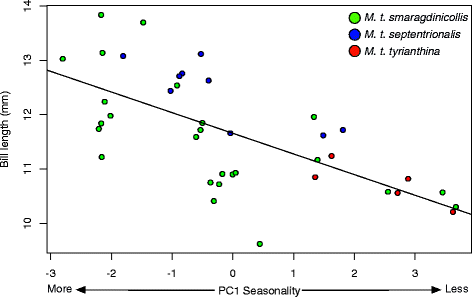The dual role of Andean topography in primary divergence: functional and neutral variation among populations of the hummingbird, Metallura tyrianthina
- PMID: 26801894
- PMCID: PMC4724075
- DOI: 10.1186/s12862-016-0595-2
The dual role of Andean topography in primary divergence: functional and neutral variation among populations of the hummingbird, Metallura tyrianthina
Abstract
Background: The ridges and valleys of the Andes create physical barriers that limit animal dispersal and cause deterministic local variation in rainfall. This has resulted in physical isolation of animal populations and variation in habitats, each of which has likely contributed to the evolution of high species diversity in the region. However, the relative influences of geographic isolation, ecoclimatic conditions, and their potential interactions remain poorly understood. To address this, we compared patterns of genetic and morphological diversity in Peruvian populations of the hummingbird Metallura tyrianthina.
Results: Phylogenetic and variation partitioning analyses showed that geographic isolation rather than climatic dissimilarity explained the greatest proportion of genetic variance. In contrast, bill length variation was explained by climatic seasonality, but not by genetic divergence. We found that mutation-scaled migration rate (m) between persistently humid and semi-humid environments was nearly 20 times higher when the habitats were contiguous (m = 39.9) than when separated by a barrier, the Cordillera de Vilcanota (m = 2.1). Moreover, the population experiencing more gene flow exhibited a lesser degree of bill length divergence despite similar differences in climate.
Conclusions: Geographic isolation is necessary for genetic divergence. Ecological differences, represented here by climate characteristics, are necessary for functional divergence. Gene flow appears to hinder the evolution of functional traits toward local adaptive optima. This suggests that functional diversification requires geographic isolation followed or accompanied by a shift in ecological conditions. Andean topography causes both isolation and climatic variation, underscoring its dual role in biotic diversification.
Figures





Similar articles
-
The role of geography and ecology in shaping the phylogeography of the speckled hummingbird (Adelomyia melanogenys) in Ecuador.Mol Phylogenet Evol. 2007 Jun;43(3):795-807. doi: 10.1016/j.ympev.2006.11.006. Epub 2006 Nov 17. Mol Phylogenet Evol. 2007. PMID: 17208464
-
Evolutionary patterns of diversification in the Andean hummingbird genus Adelomyia.Mol Phylogenet Evol. 2011 Aug;60(2):207-18. doi: 10.1016/j.ympev.2011.04.007. Epub 2011 May 4. Mol Phylogenet Evol. 2011. PMID: 21558009
-
Selection and geographic isolation influence hummingbird speciation: genetic, acoustic and morphological divergence in the wedge-tailed sabrewing (Campylopterus curvipennis).BMC Evol Biol. 2011 Feb 8;11:38. doi: 10.1186/1471-2148-11-38. BMC Evol Biol. 2011. PMID: 21299905 Free PMC article.
-
Identifying mechanisms of genetic differentiation among populations in vagile species: historical factors dominate genetic differentiation in seabirds.Biol Rev Camb Philos Soc. 2020 Jun;95(3):625-651. doi: 10.1111/brv.12580. Epub 2020 Feb 5. Biol Rev Camb Philos Soc. 2020. PMID: 32022401 Review.
-
The genetics of evolutionary radiations.Biol Rev Camb Philos Soc. 2020 Aug;95(4):1055-1072. doi: 10.1111/brv.12598. Epub 2020 Mar 31. Biol Rev Camb Philos Soc. 2020. PMID: 32233014 Review.
Cited by
-
Linking large-scale genetic structure of three Argynnini butterfly species to geography and environment.Mol Ecol. 2022 Aug;31(16):4381-4401. doi: 10.1111/mec.16594. Epub 2022 Jul 15. Mol Ecol. 2022. PMID: 35841126 Free PMC article.
-
Hierarchical genetic structure shaped by topography in a narrow-endemic montane grasshopper.BMC Evol Biol. 2016 May 5;16:96. doi: 10.1186/s12862-016-0663-7. BMC Evol Biol. 2016. PMID: 27149952 Free PMC article.
-
Divergence and Selection in a Cryptic Species Complex (Geonoma undata: Arecaceae) in the Northern Andes of Colombia.Genome Biol Evol. 2025 Jul 3;17(7):evaf130. doi: 10.1093/gbe/evaf130. Genome Biol Evol. 2025. PMID: 40691772 Free PMC article.
-
On geographic barriers and Pleistocene glaciations: Tracing the diversification of the Russet-crowned Warbler (Myiothlypis coronata) along the Andes.PLoS One. 2018 Mar 9;13(3):e0191598. doi: 10.1371/journal.pone.0191598. eCollection 2018. PLoS One. 2018. PMID: 29522515 Free PMC article.
-
Let's get high: Cladogenesis in freshwater crabs (Decapoda: Potamonautidae: Potamonautes) supports the mountain gradient speciation hypothesis in the Cape Fold and Drakensberg Mountains, South Africa.Ecol Evol. 2024 Mar 5;14(3):e10960. doi: 10.1002/ece3.10960. eCollection 2024 Mar. Ecol Evol. 2024. PMID: 38450318 Free PMC article.
References
Publication types
MeSH terms
Substances
LinkOut - more resources
Full Text Sources
Other Literature Sources

